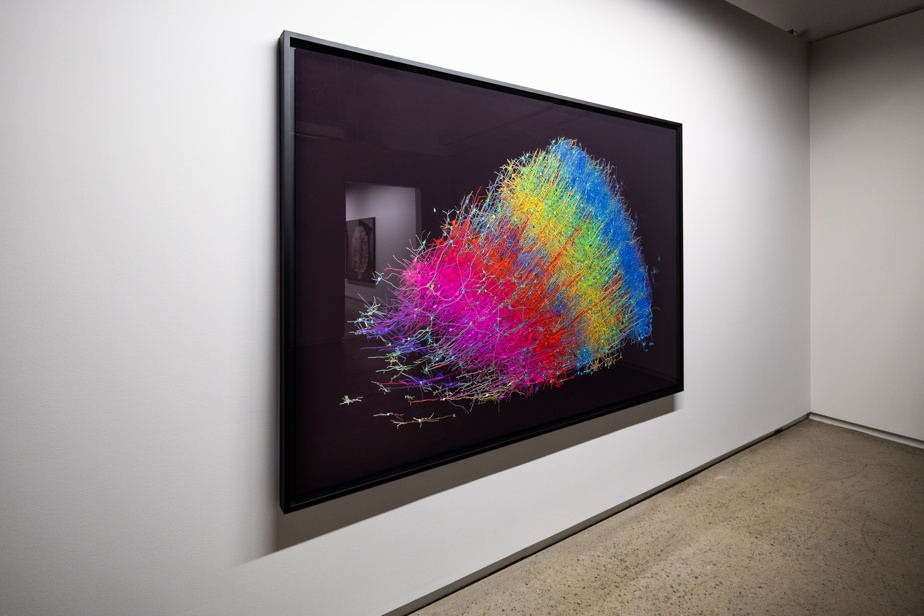One from Quebec, the other from America… Two great women recognized in the history of art are present in Montreal galleries this fall. The first, Geneviève Cadieux, exhibits her most recent production at Blouin Division, while for the second, Joan Mitchell, works on paper have been meticulously chosen to occupy the spaces of the Galerie Simon Blais.
Geneviève Cadieux, between body and nature
Active since the 1980s, photographer Geneviève Cadieux offers at Blouin Division to revisit the body, but this time, from the inside. Indeed, she is known in particular for her works which present close-up details of the skin. Everyone has undoubtedly already looked at his public installation, The Milky Way (1992), on the roof of the Museum of Contemporary Art in the Quartier des Spectacles which features an image of red lips in the style of an advertising poster.
For her current solo, Geneviève Cadieux remains true to herself and offers a journey which reveals a deconstructed story, with an experimental aim, but in which all the compositions resonate with each other in a free way.

PHOTO SARAH MONGEAU-BIRKETT, THE PRESS
The exhibition Wild Is the Wind is an exhibition presenting the new works of Geneviève Cadieux, at the Blouin Division gallery, in Griffintown.
At the entrance, a long sentence in white block letters on the chair rail is inspired by the text Body, remember by the Greek poet Constantin Cavafy. She opens the ball Wild Is the Wind : “My body, remember how much you were loved”. Like a link between the creations for visitors, these words lead directly to two digital prints of plants named “uniflora monotrope” of dazzling whiteness, here dried and in negative. They echo the works in the next room occupied by the artist Pascal Grandmaison. Invited by Geneviève Cadieux, he presents parts of plants where the perspective seems to have been truncated.
But what mainly attracts attention is the final room whose compositions embody and summarize the body-nature relationship of Cadieux’s work. The series The place of the mind presents images of the brain in a very poetic manner, to which gold and palladium leaves as well as colored silver leaves have been added. An ambiguity hovers over these representations, between the evocation of bodily parts and elements of nature.
-

PHOTO SARAH MONGEAU-BIRKETT, THE PRESS
Geneviève Cadieux, The place of the mind2023-2024, 157 x 213 cm. Digital prints on Canson paper, enhanced with gold leaf, palladium leaf and colored silver leaves
-

PHOTO SARAH MONGEAU-BIRKETT, THE PRESS
Geneviève Cadieux, Ghost Flower 1 And Ghost Flower 22024, 126 x 95 cm. Digital prints on Canson paper, raised with palladium foil.
-

PHOTO SARAH MONGEAU-BIRKETT, THE PRESS
Geneviève Cadieux, The place of the mind (detail), 2023-2024, 157 x 213 cm. Digital prints on Canson paper, enhanced with gold leaf, palladium leaf and colored silver leaves.
1/3
Ultimately, Geneviève Cadieux suggests more universal and simple experiences in this exhibition. It’s about thinking about memory, spirituality, passion, love and emotions…
Joan Mitchell and paper works

PHOTO MARTIN CHAMBERLAND, THE PRESS
Exhibition view Joan Mitchell and her contemporaries at the Simon Blais Gallery
The painter and engraver Joan Mitchell, too often referred to only as the companion of Jean Paul Riopelle, nevertheless had a flamboyant career of her own. The artist participated in the advances of the American abstract expressionism movement and the New York School which developed after World War II. Mitchell is one of the most important artists of her generation and she is very recognized in the United States, but she seems to be a little less so in Quebec. The exhibition at Simon Blais remedies the situation by presenting six lithographs by the artist as well as several other creations by his contemporaries.
No paintings by Mitchell, then, in the exhibition? Since these can sell for millions of dollars, the gallery owner instead offers accessibility through the exhibition of prints. Works on paper have also been a specialty of Simon Blais for several years.

PHOTO MARTIN CHAMBERLAND, THE PRESS
Joan Mitchell, Trees III1992. Lithograph on paper, 144 x 209 cm.
The prints in the spotlight are dated from the 1980s and 1990s, produced towards the end of the career of the artist who produced for almost four decades.
We can still detect certain reminiscences of abstract expressionism – the large format, the gesture, and the use of large colored areas with evocative titles which testify to Joan Mitchell’s inspirations, particularly nature.
The exhibition also includes other major players and actresses in modern and contemporary art who deserve special attention. If engravings by Jean Paul Riopelle and Sam Francis, American artist and friend of Joan Mitchell, are hung in the first room, let us especially highlight the presence of a striking black and white painting by Suzanne Meloche, member of the Automatistes, who contributed to the movement in particular through his poetry. Confrontation (1964) is worthy ofaction painting and is reminiscent of the production of the American abstract artist Franz Kline.
-

PHOTO MARTIN CHAMBERLAND, THE PRESS
Confrontation, by the artist Suzanne Meloche, made in 1964. Oil on canvas, 122 x 184.5 cm.
-

PHOTO MARTIN CHAMBERLAND, THE PRESS
Exhibition view Joan Mitchell and her contemporaries
-

PHOTO MARTIN CHAMBERLAND, THE PRESS
Joan Mitchell, Champs (or Fields)1990. Lithograph on paper, 150 x 100 cm.
-

PHOTO MARTIN CHAMBERLAND, THE PRESS
Damien Hirst, Dumpling (from the Last Supper)1999. Silkscreen on paper, 153.5 x 101.5 cm.
1/4
Damien Hirst is also invited to the exhibition where his work Dumplingsfrom his series From the Last Supper (1999), surprises with its aesthetic completely different from the rest, figurative and integrating text. Visitors find themselves in front of what could be an image of a medicine box. At least that’s what one might read on the “label”.
Wild Is the Wind is on display until October 22 at the Galerie Blouin Division.
Visit the exhibition page
Joan Mitchell and her contemporaries is on display until October 26 at the Galerie Simon Blais.
Visit the exhibition page
